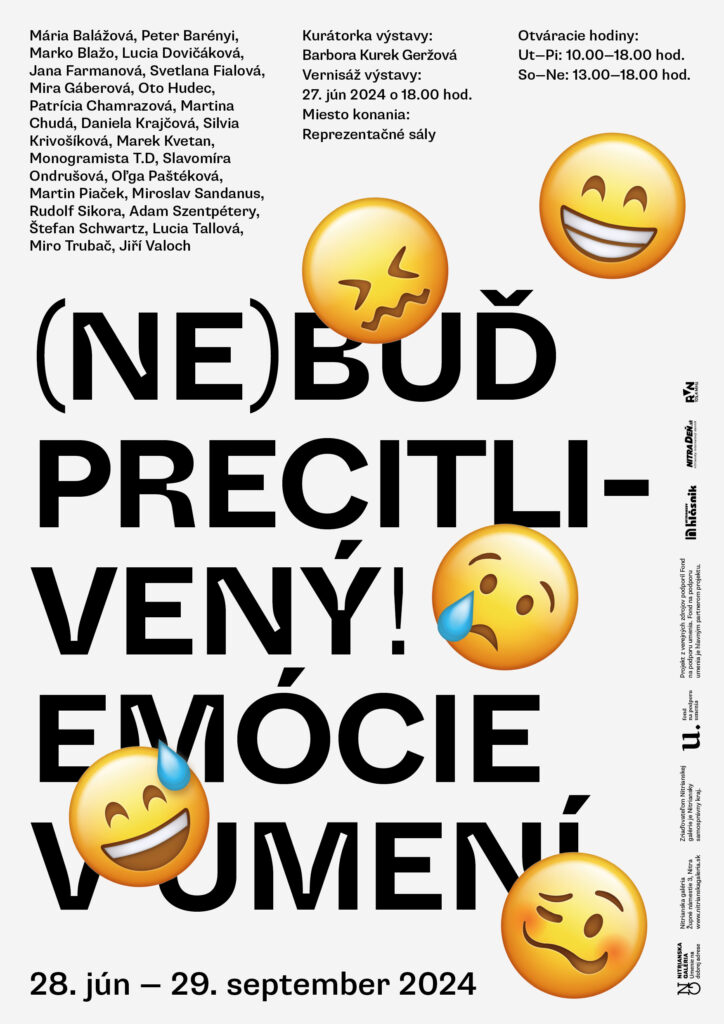Information
Artists
Mária Balážová, Peter Barényi, Marko Blažo, Lucia Dovičáková, Jana Farmanová, Svetlana Fialová, Mira Gáberová, Oto Hudec, Patrícia Chamrazová, Martina Chudá, Daniela Krajčová, Silvia Krivošíková, Marek Kvetan, Monogramista T.D, Slavomíra Ondrušová, Oľga Paštéková, Martin Piaček, Miroslav Sandanus, Rudolf Sikora, Adam Szentpétery, Štefan Schwartz, Lucia Tallová, Miro Trubač, Jiří Valoch
Curator
Barbora Kurek Geržová
Opening
June 27, 2024, 6pm
Duration
June 28 – September 29, 2024
Venue
Representative Halls
Download
Don’t be oversensitive! You might have heard it somewhere before or perhaps even told that to someone who might have given the impression they were “overtaken” by their emotions. This notion and its various forms have found their way into current parenting methods where it is supposed to helps children cope with or stop “inappropriate” emotions, manage them and control the subsequent behaviour in order to make them stronger and more resilient.
I have borrowed this stereotypical expression – Don’t be oversensitive! – and used it in the title of an exhibition which explores the presence of emotions in art at a time when we start to look at them a little differently than previous generations. Where has the increased need to express emotions in art recently come from? What does this turn to emotions not just in art, but also generally in society signal? Right now, we have a chance to observe how people’s position to emotions slowly changes and also affects the way we experience and express them. We live at a time when people start to talk more and more about mental health, psychological balance (well-being), emotional intelligence. We educate ourselves, work on self-development. We learn how to be in contact we our emotions – how to identify them, accept them, experience them and find the right tools to cope with them. We become more authentic and vulnerable. It is also apparent in the works by artists who are not afraid to talk about their experiences, feelings, emotions, vulnerabilities and traumas. They are trying to overcome established behavioural patterns which had previously taught us to be afraid of emotions, to avoid and suppress them, not to show them, fight them or not feel them at all.
The exhibition focuses on various strategies and tools that artists use to deliver their emotional experiences and what affects their style and language. We can talk about their temperament, personality, but they are also largely affected by the environment they grew up in, their upbringing, experience, generational and broader cultural and social contexts. We will examine this theme from various angles. On one hand, we will map those works which express emotions clearly and explicitly, where they become a theme in it of themselves and where artists work with emotions mostly deliberately in order to communicate their own experience. Their work thus turns into self-expression, self-realisation, a record of their psychological processes. On the other hand, the exhibition will take a look at works we do not associate with emotions at first glance, we cannot decipher them immediately, but they are present in them nonetheless. Finally, we will explore how emotions used to be treated in the broader context of the history of art and across individual art movements. How were emotions processed in geometric abstraction (which is often described as rational, impersonal, cold) or conceptual art (which prioritises the actual idea and a clean intellectual experience). We will take a look at how much space were emotions given in the interpretation of individual works. Why did certain time periods suppress emotions and what kind of interpretation strategies they preferred instead.

